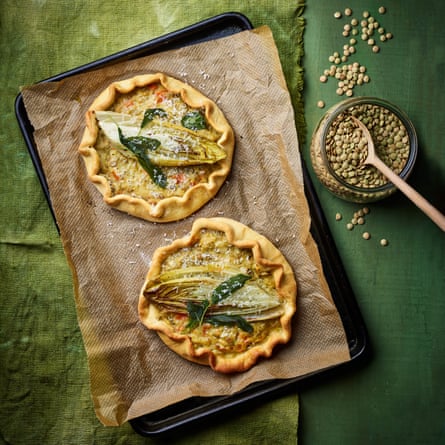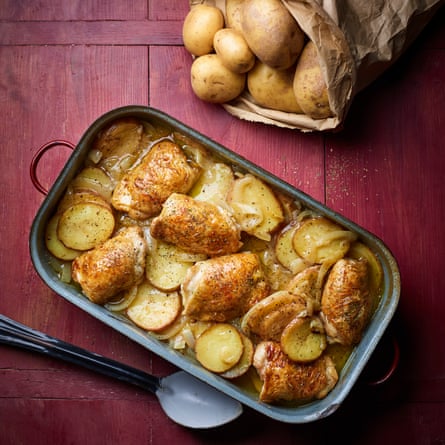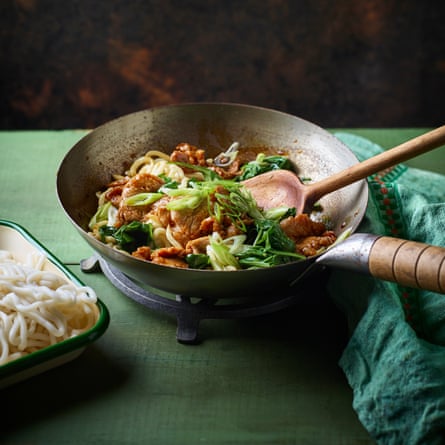
How we did it
Aside from allowing for basic store cupboard ingredients – such as salt, pepper, olive oil, flour, dried herbs – we asked our cooks to calculate the cost of shopping from scratch at major supermarkets. You will have some leftover ingredients which will, of course, keep for other meals. The cost of each recipe was correct at time of going to press.
The ingredient: cheese
The recipe: Joe Woodhouse’s cheese souffle
This dish feels luxurious beyond its humble ingredients, with the pink quick-pickled onions keeping the richness in check. I love it as a main that everyone can get stuck into around the table.
Cooking in a bain-marie really helps the texture and results in a steady rise. I use a cast iron enamel pot to cook it in. A cake tin or a deep pie dish would also work. Using a wholegrain flour adds a little nutty note to the souffle.
Mustard powder really shines here, but dijon also holds its own. Add half and taste: I like it quite noticeable, so I use the full amount. You can let the cheese sauce cool before adding the eggs, if you want to get ahead. But working swiftly while everything is hot gets a jump start on the cooking. Serve it straight from the oven at the table, steaming away in all its glory.
Serves 4
red onions 2, about 400g, finely sliced
red wine vinegar 3 tbsp (cider or white wine vinegar also work fine)
flour 60g (brown adds a nuttiness, but any works)
unsalted butter 125g
full fat milk 300ml
cheddar cheese 175g
eggs 6 medium, separated
dijon mustard 1-2 heaped tsp, or mustard powder
new potatoes 750g
leeks 250g, roughly sliced
Joe’s total cost: £7.98 (items bought from Sainsbury’s)
Set the oven to 200C fan/gas mark 7. Firstly, mix the red onions with the vinegar and a pinch of salt, and set aside.
Over a medium heat, toast the flour in 60g of the butter for 2-3 minutes until golden and aromatic. Add half the milk, and with a spatula or a whisk incorporate it fully into the flour and butter. Add the rest of the milk and mix until a smooth roux is formed. Continue to stir over the heat until the sauce has thickened – 2-3 minutes should get you there. Take off the heat.
Grease a 20cm x 9cm pan or dish with 15g of butter. Then finely grate 25g of cheese directly into the dish trying to coat the sides as much as possible. Rotate the dish and coax any remaining cheese on to buttered areas to cover.
Either by hand or in a machine, whisk the egg whites to stiff peaks with a pinch of salt. Beat the egg yolks one at a time into the sauce. Once fully incorporated, mix through the rest of the cheese, the mustard and a pinch of salt. Taste for the level of mustard you like, add more if needed. Stir the egg whites through the cheese mix a quarter at a time, until fully incorporated. Be careful not to knock out too much air from the egg whites.
Pour the mix into your dish. Set in a high-sided oven tray filled with 2cm of water. Place in the oven and bake for 30 minutes. Turn the tray 180 degrees and continue cooking for another 10-15 minutes until golden on top and set.
Meanwhile, cook the potatoes in salted water until tender. At the same time add the leeks to the remaining 50g of butter in a medium saucepan. Cook gently with a lid on the pan over a medium-low heat until collapsed and tender. Toss the potatoes in the leeks with a good grind of black pepper. Serve alongside the souffle with the quick-pickled onion.
Joe Woodhouse is a food writer and photographer, and author of Your Daily Veg (Kyle Books, £22)
The ingredient: lentils
The recipe: Joe Trivelli’s lentil and chicory torta salata
I started making a lot of savoury vegetable pies years ago, after a spell cooking in Liguria. There have been many versions since and currently it’s with lentils. You could use another type, but small green or brown lentils are what I like at the moment; puy would be nuttier, red are creamier.
Lentils cooked like this and dressed with olive oil are a meal by themselves in our house. My aunt says you cannot cook lentils with tinned tomatoes and I kind of know what she means, but I still use one or two out of a tin when that’s all I have.
Serves 4
plain flour 300g
baking powder 1 tsp
salt 1 tsp
olive oil 30ml
cold water 150ml
potatoes 250g
carrots 2
garlic 3 cloves
green lentils 125g
tomatoes 100g
chicory 2
sage a small bunch
parmesan 60g, grated
eggs 2 medium
nutmeg
salt and pepper
Joe’ s total cost: £7.60 (items bought from Sainsbury’s)
To make the pastry, sieve together the flour and baking powder into a large bowl. Add the salt, olive oil and cold water. Mix briskly, turning the flour with open fingers until it forms clumps, then mix and press until it comes together. Move the dough to the workbench and knead for 3 minutes. It will become smooth and more elastic. Divide into 4 and knead into balls. Cover them and set aside to rest for at least 30 minutes.
Peel the potatoes, carrots and garlic. Cut the potatoes into large chunks and add them with the carrots, garlic, tomatoes and lentils to a pan. Cover with water about 8cm above the level of the lentils.
Bring to the boil, then turn down to a simmer. Top up the level of the water frequently in small doses and simmer for 25-30 minutes or until the vegetables and the lentils are soft. Once cooked, drain away any excess water and stir with a spoon, breaking up the carrots and smushing the potatoes and tomato. Stir in a little oil, season and set aside.
Cut each chicory in two, lengthways. Boil in a pot of salted water for 5 minutes. Drain and, once cool enough, give them a squeeze to remove excess water. Dress with a little olive oil, the sage leaves and a tablespoon of the parmesan.
Heat the oven to 160C fan/gas mark 4. Lightly oil or line a baking sheet with parchment paper. Mix the eggs into the lentil mixture with the rest of the cheese and a good scratching of nutmeg.
Dust the workbench and pastry with a little flour and roll flat the 4 pieces one by one. Pick them up, lightly dust again and turn until they are each roughly 20cm wide.
Once all 4 pieces are rolled, put the first on a corner of the baking sheet. Place a quarter of the lentils in the middle, keeping a border clean. Gently press in one of the chicory halves and arrange artfully with some sage leaves on top. Curl the edges of the pastry around to enclose. This doesn’t have to be neat. Repeat with the others, one at a time making them directly on the baking tray.
Bake for 25 minutes, then remove from the oven and brush or drizzle the edges with a little oil and return to the oven for another 15 minutes or so until golden in places. Serve warm.
Joe Trivelli is co-executive head chef of the River Cafe, London
The ingredient: potatoes

When I think simple yet delicious, I think chicken and potatoes. Potatoes are my go-to option for a cheap, budget base of any dish, as they can soak up so much flavour and everyone has them in the kitchen. This dish takes the classic boulangere potato of layers of sticky delicious onion, stock and potatoes, and adds a lemon twist to complement your herby chicken thighs. Perfection in one pan.
Serves 4
maris piper potatoes 5
chicken thighs 6, skin on
onions 3
oil
salt and pepper
chicken stock cubes 2
lemons 2
frozen garden peas about 2 mugs
dried Italian herbs
Poppy’s total cost: £7.70 (items bought from Tesco)
Preheat the oven to 180C fan/gas mark 6.
Cut your potatoes into 1cm-thick slices. Peel and halve the onions, then slice them into 1cm-thick half moons.
In a large pan (or two) fry off your potatoes and onions in a little oil until some pieces have browned slightly. Season with salt and pepper.
Tip your potato mixture into an ovenproof baking dish.
Make 1 litre of chicken stock, according to the stock cube packet instructions. Squeeze the lemons and add the juice to the stock. Pour it over your potatoes, until everything is covered with the liquid.
Drizzle your chicken thighs with oil and rub it all over, then sprinkle with salt, pepper and some dried herbs (Italian style ones work well). Place the thighs on top of the potatoes, just pushing them down so that about a third of the thigh is submerged in the lemony chicken stock.
Place in the oven and cook for 40 minutes until the potatoes are soft but browned on top, and the chicken thighs are golden and cooked through.
Just before the chicken and potatoes are cooked, boil a pan of water and cook the frozen peas for about 2 minutes, then drain. Serve alongside those delicious lemony, sticky, golden potatoes.
Poppy O’Toole is a judge on Young MasterChef and author of Poppy Cooks: The Food You Need (Bloomsbury, £16.99)
The ingredient: rice
The recipe: Melissa Thompson’s chorizo, pea and lemon rice

I have cooked a version of this dish for about 15 years. It began as a means to use up things I always seemed to have – chorizo, cheese and lemons. It has changed many times, sometimes with the addition of leftover chicken, occasionally with other vegetables and maybe a scattering of parsley over the top.
It’s tasty and comforting, with echoes of risotto, but ultimately it’s just a great vehicle for different ingredients that you need to make the most of.
Serves 4
brown bread 2 slices
oil 3 tbsp (vegetable, sunflower or rapeseed)
grana padano 80g (or any other hard cheese)
chorizo 100g, roughly chopped
white onion 1, finely chopped
garlic 2 cloves, crushed
arborio rice 350g
chicken or vegetable stock 800ml to 1 litre, hot
frozen peas 250g
lemon 1, zested and cut into quarters
butter a knob
Melissa’s total cost: £7.62 (items bought from Sainsbury’s)
Blitz two slices of bread, crusts too, in a food processor. Fry with 2 tablespoons of the oil in a frying pan over a medium heat for 5-7 minutes until crisp, stirring regularly. Just before you take them off the heat, add 20g of grated grana padano and stir through. Remove to a bowl to cool.
In the same pan, fry the chorizo in another splash of oil. Cook for a couple of minutes until the oil has been released. Remove half to a bowl leaving as much of the oil in the pan as you can, and then fry the onion in it. After 4 minutes, add the garlic and cook for another couple of minutes.
Add the rice and stir through to cover the grains with the oil. After 2 minutes, gradually add the stock, stirring each time until it is almost fully absorbed into the rice before adding more. Taste the rice and once it is almost cooked – still with a chalky bite but almost there – add the peas and lemon zest.
Continue cooking until the rice is ready, which will take about 15-18 minutes in total. Turn off the heat, stir through the butter and remaining cheese and chorizo, and serve in bowls.
Scatter the breadcrumbs over the top and serve with a wedge of the zested lemon to squeeze over.
Melissa Thompson is a food writer and the author of Motherland (Bloomsbury, £26)
The ingredient: noodles
The recipe: Fuchsia Dunlop’s Shanghainese stir-fried udon noodles with pork

Since time immemorial, Chinese cooks have been cutting their ingredients into small pieces, mixing them in various combinations and eating with chopsticks. One effect of this is that meat, slivered or sliced and cooked with vegetables, goes further, which is helpful if you are trying to eat more affordably.
The food of Shanghai is rooted in the traditions of the eastern Jiangnan region, with its rich soy-based sauces, delicate seafood and fine seasonal produce. Interwoven with this are the traces of more than a century of international contacts. In Shanghai, you can find local versions of schnitzels, borscht and Worcestershire sauce, as well as this dish, which is made with Japanese noodles.
Serves 4
lean pork 200g
spring onions 2
sunflower or rapeseed oil 3 tbsp
fresh udon noodles 600g
light soy sauce 3 tbsp
dark soy sauce 2 tsp
sugar 1 tsp
salt and ground pepper
baby spinach leaves 3 handfuls
For the marinade
salt ¼ tsp
light soy sauce 1 tsp
cornflour 4 tsp
cold water 2 tbsp
Fuchsia’s total cost: £7.94 (items bought from Sainsbury’s)
Cut the pork, against the grain, as evenly as possible into slivers ½cm thick. Place in a bowl with the marinade ingredients and mix well. Trim the spring onions and cut into fine slivers, separating the green and white parts.
Heat 1½ teaspoons of the oil in a seasoned wok over a high flame. Add the pork slivers and stir-fry to separate. When the slivers are just cooked through, remove from the wok and set aside.
Return the wok to a high flame. When hot, add 1½ teaspoons of oil and swirl around. Add the spring onion whites and stir briefly. Tip in the noodles and stir-fry for a few minutes until piping hot, then add the soy sauces and the sugar, with salt and pepper to taste, and mix well.
Add the spinach leaves and spring onion greens, and stir through until wilted. Finally, return the pork slivers to the wok, mix well and serve.
Fuchsia Dunlop is a food writer and author of The Food of Sichuan (Bloomsbury, £30)


